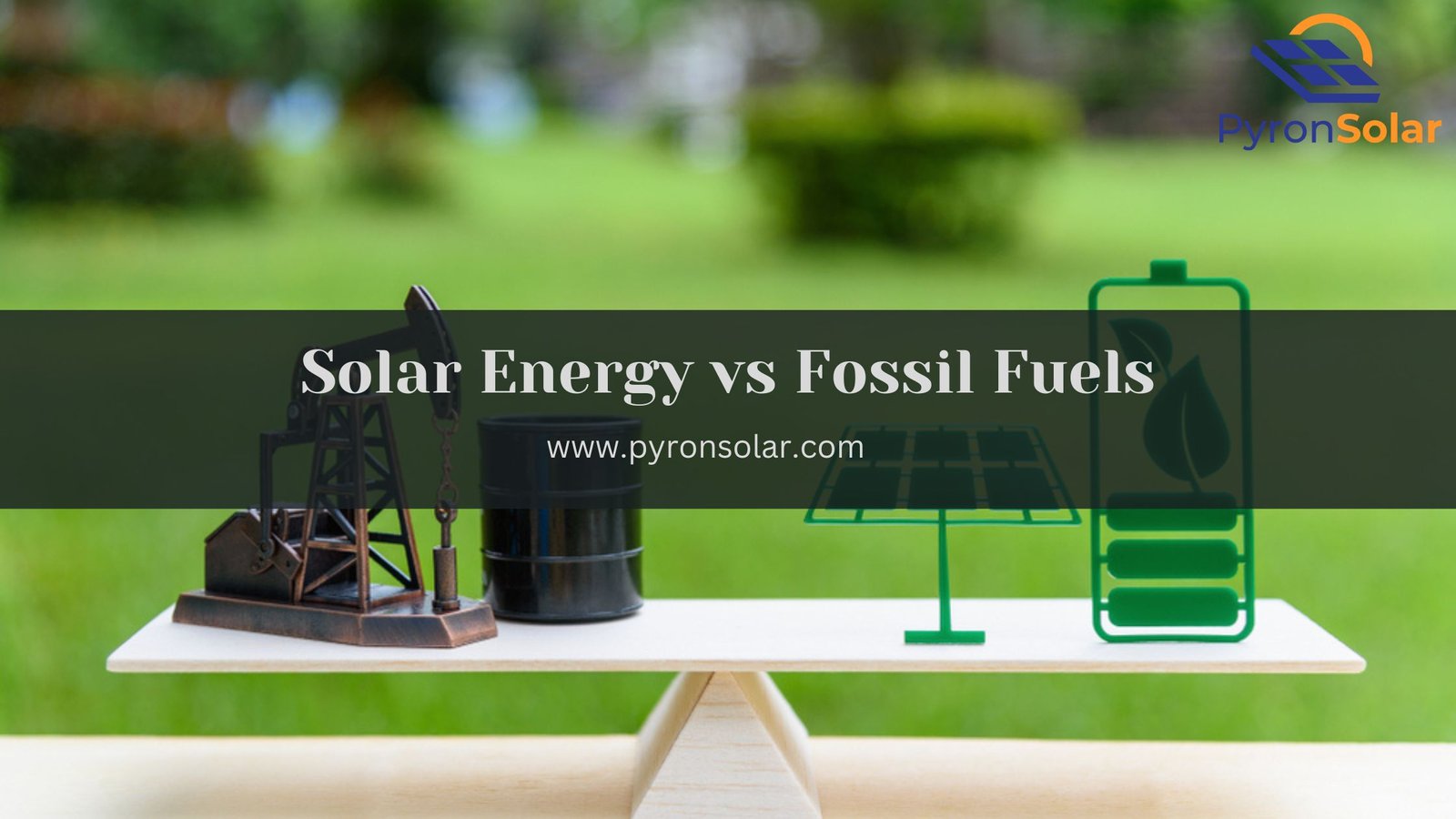Solar energy is a renewable and infinite source of energy harnessed from the sun’s radiation to generate heat and electricity using solar thermal technologies and photovoltaic cells, whereas Fossil Fuels are non-renewable sources formed from the ancient remains of organisms like plants and animals that lived millions of years ago. Natural resources like coal, petroleum, and natural gas are formed from the organic matter of living organisms.
Knowing the advantages and disadvantages of solar energy and fossil fuels becomes crucial in making informed decisions about its efficiency, energy use, economic considerations, resource availability, technological innovations, environmental impact, energy security, and dependence.
Earlier, Solar energy was considered more expensive than fossil fuels, but the recent development in technology and depletion of fossil fuels changed the entire landscape. After knowing what solar energy is, how to use it, and its pros and cons, new solar panel technologies will help you understand how advanced solar energy has become.
By delving into the comparative analysis of solar energy vs fossil fuels you will come to know which is the better option by viewing the health and economic impact of these energy sources that could help to implement the best plan for energy storage and distribution.
What is Solar Energy?

Solar energy is an inexhaustible resource harnessed using solar panels to capture sunlight and convert it into heat or electricity. The Photovoltaic (PV) cells in the solar panels are made up of semiconductor materials like silicon.
When the sunlight strikes the junction between two different semiconductors, a single PV cell generates power of about only 2 watts. However, thousands of kilowatts of electric power can be generated in a solar plant or residential building by connecting a large number of cells in solar panel arrays. An inverter converts the DC (Direct Current) into AC (Alternating Current), by making it compatible with household appliances and the electric grid. The converted electricity is used to power residential and commercial buildings immediately or by storing the energy for future use.
Solar energy is gaining popularity for several reasons because of its low operation cost, sustainable and renewable source of energy, job creation, scalability, cost-effectiveness, environmentally friendly, and many more…
There are several benefits of solar energy, out of which, a few are listed below:
- Doesn’t release any greenhouse gas emissions
- Conserves natural resources
- Doesn’t deplete water resources
- Reduces reliance on fossil fuels
- Less maintenance
- Job opportunities in several sectors like manufacturing, maintenance, research, and development, etc. and many more…
There is a lot more to know about “What is Solar Energy?“, Origin of Solar Energy, Types, History, Future, etc.
What are Fossil Fuels?

Fossil Fuels are the decomposed materials of plants and animals that are found under the earth’s crust and consist of Hydrogen and Carbon that can be burned to produce energy.
By using extraction methods like horizontal and vertical drilling, surface and underground mining, and hydraulic fracturing can be used depending on the fuel type and location.
Coal can be used for electricity generation and industrial processes. Oil (Petroleum) which is formed from the remains of marine organisms can be used to prepare various products like gasoline and diesel. Natural gas which is composed of methane is similar to the process of oil formation, but it’s used for heating, electricity generation, and supply feedstock for chemical production.
The use of fossil fuels severely impacts the environment such as emitting greenhouse gas emissions that cause air pollution and severe respiratory problems, water pollution caused due to extraction and transportation. Mainly, the natural habitat gets destroyed on a large scale.
Despite the massive depletion rate of fossil fuels on a large scale, they still dominate the global energy landscape. In 2023, over 60% of the electricity was produced 2023 by fossil fuels which are used by countries like the United States (59%), China (65%), India (75%), Japan (63%), Poland (73%) and Turkey (57%). It is because of the wide infrastructure, and economic factors making it is cheaper than other renewable sources and has higher energy density.
Comparative Analysis of Solar Energy vs Fossil Fuels
These are important parameters to consider in the comparative analysis of solar energy and fossil fuels with their benefits and drawbacks:
1. Energy Source: Solar energy is derived from the sun’s radiation captured through various technologies like solar panels whereas fossil fuels are obtained through the source of dead plants and animals buried deep underground for millions of years.
2. Efficiency and Reliability: Fossil fuels have higher energy conversion efficiency by providing a reliable and consistent power supply when compared to solar energy.
3. Availability: In contrast to fossil fuels have finite availability and get exhausted over some time, solar energies are abundant and inexhaustible which makes them suitable for the long run.
4. Environmental impact: Fossil fuels release harmful greenhouse gases like carbon dioxide, which has a severe impact on the environment. Though, solar energy emits minimal greenhouse gases during the manufacturing process, but reduces the carbon footprint compared to fossil fuels.
Cost
Various factors determine the approximate cost for both fossil fuels and solar energy:
1. Fossil Fuels: The initial investment includes the extraction and processing costs of fossil fuels for the following:
- Coal: 100 to 500 million USD for building a coal mine
- Oil: 20 to 50 million USD per well
- Natural gas: 5 to 20 million USD per well
The price for various equipment like excavators, conveyor belts, Drilling rigs, pumps, and separators varies according to the needs and technology. Costs are Spread over large volumes of extracted fuel which leads to low prices per unit starting from one to ten or hundred million USD.
The operational and maintenance cost fluctuates based on skilled labor, infrastructure maintenance, and pipeline architecture for transportation.
According to the estimation by the International Monetary Fund (IMF), global fossil fuels subsidies were $5.9 trillion in 2020.
2. Solar Energy: The initial investment for panels and equipment for solar energy ranges between $2.50 to $3.50 per watt which is very high due to the operational and maintenance costs between $100-$200 annually and inverter replacements after 10 to 15 years for $1,000-$2,000. Additional equipment like batteries might cost $7,000 to $14,000 for residential systems.
Typically, solar panels have a warranty of up to 25 years. Contrarily an inverter has a 10 to 12 years warranty.
Under the Federal Solar Tax Credit, 30% of the system cost is capped at $2,000 per year. Consequently, it reduces the effective cost of a 6KW system by $4,500-$6,750.
Many governments offer additional rebates, tax credits, or exemptions that start from a few hundred dollars to several thousand. The net metering concept allows you to sell excess solar energy back to the grid by reducing your electricity bills.
Environmental Impact
Both Fossil fuels and solar energy have a major impact on the environment:
1. Fossil Fuels: The combustion process in fossil fuel releases carbon dioxide (CO2), methane (CH4), and nitrous oxide (N2O) among other greenhouse gases into the atmosphere that traps heat and causes global warming.
Air pollution is caused when pollutants like sulfur dioxide (SO2), nitrogen oxides (NOx), and particulate matter (PM) are released during combustion, which contributes to smog, acid rain, and various respiratory problems.
The extraction, processing, and transportation can cause water pollution that occurs due to oil spills, and fracking for natural gas.
Most often there is an ecological imbalance like habitat destruction, deforestation, species extinction, and several others during the extraction. Also, oil spills affect the marine ecosystem and disrupt the food chain.
2. Solar Energy: According to the U.S. Department of Energy, solar energy isn’t involved in the process of greenhouse gas emissions compared to fossil fuels.
The water consumption is very low as the solar PV panels require occasional cleaning, which makes it suitable in regions with water scarcity.
Solar farms require a considerable space of land area that can cause habitat loss, soil degradation, and reduce biodiversity.
The manufacturing process involves various materials like silicon, glass, and rare earth elements like indium, gallium, and selenium. Despite the operation of solar panels having lower effects on the environment, the manufacturing process emits greenhouse gases by often relying on fossil fuels.
Despite the improving rates of the recycling process, improper disposal methods remain a huge challenge thereby contributing to environmental contamination. Additionally, there is a lot more to know about the environmental impacts of solar energy.
{Video Credit- Engineering with Rosie}
Efficiency
The efficiency factors for both fossil fuels and solar energy vary as shown below:
1. Fossil Fuels: The higher energy density produced by coal ( 8,100 kWh per ton), oil (11,700 kWh per ton), and Natural gas (10,500 kWh per ton) makes fossil fuels suitable for various applications.
The combustion process will have an average energy conversion efficiency of 30 to 40% ( coal- 35%, natural gas- 45%, and oil-fired power generation-38%). In other words, only a fraction of energy is converted into useful energy whereas the remaining is lost as waste heat into the environment.
Burning fossil fuels leads to energy loss due to friction and other processes and heat generated in the combustion process escapes through the cooling system or exhaust fans.
Fossil fuel-based power plants have larger flexibility and reliability to supply non-stop electricity even during its peak demand. But, flexibility can be expected only on a short-term basis. Baseload power and grid stability are provided in regions where the penetration of renewable energy is limited.
2. Solar Energy: Typically, solar panels have an average conversion efficiency of 15 to 20%, which is lower than fossil fuels (30 to 40%) but these renewable energy sources make significant progress.
Despite the lower energy conversion rates, solar panels provide long-term energy production with minimum degradation and a warranty of 25 to 30 years.
Compared to the cloudier areas, solar panels generate more electricity where there is abundant sunlight and minimum cloud cover. At the same time, the solar panel efficiency can decrease at too hot or cold temperatures. Additionally, installing rooftop solar panels reduces transmission losses and grid dependence.
The technological innovations in the solar energy industry have been rapid by increasing the efficiency of solar panels, reducing manufacturing costs, and introducing energy storage techniques such as lithium-ion batteries.
Resource Availability
Solar energy has an unlimited availability of resources compared to fossil fuels:
1. Fossil Fuels: The formation of fossil fuels is extremely slow as it takes millions of years and these finite resources have a threat of depletion after a certain period.
These non-renewable energy sources are unevenly distributed across the globe. For instance, the United States, Russia, and China have the largest coal deposits whereas a majority of oil and natural gas reserves are found in the Middle East and parts of North America and Russia.
The uneven distribution causes geopolitical tensions that influence the global energy markets and international relations. Countries with limited resources may face economic inequalities and affect development. Consequently, it leads to resource disputes within and between the nations.
2. Solar Energy: Unlike fossil fuels, solar energy is inexhaustible and originates from the sun’s radiation which is estimated to last for billions of years.
The infinite source of energy is available globally, which can be accessed from different locations regardless of the less sunny areas by the advancements in technology like solar tracking systems and high-efficiency photovoltaic (PV) panels.
Extracting energy from the sun doesn’t generate heat or electricity and doesn’t emit any greenhouse gas emissions, thereby significantly contributing to a cleaner, renewable, and sustainable source of energy.
Health Impact
Solar energy has minimal impact on health in contrast to fossil fuels:
1. Fossil Fuels: Air pollutants are generated upon burning fossil fuels like particulate matter (PM), ozone (O3), and nitrogen oxide, which contribute to various respiratory diseases such as Lung cancer, heart attacks chronic obstructive pulmonary disease (COPD), and several others.
The greenhouse gas emissions can increase temperatures lead to the depletion of the ozone layer and cause other health issues like heat stroke, dengue and malaria, and food insecurity due to droughts and floods.
Extracting fossil fuels can contaminate water and soil with heavy metals such as Lead, mercury, arsenic, and cadmium causing neurological, reproductive, and many health issues.
Several injuries and accidents are caused while Mining, Drilling, and Transporting fossil fuels cause disasters like oil spills, explosions, and fires.
2. Solar Energy: In contrast to fossil fuels, solar energy doesn’t emit any pollution except during the manufacturing process, thereby reducing the reliance on kerosene lamps and diesel generators for light and electricity.
But, there are chemical hazards and workplace safety risks in the production, unless the workers take proper care.
The ongoing technological advancements aim to improve safer production by ensuring a positive contribution to public health by mitigating risks throughout the lifecycle.
Scalability and Infrastructure
The scalability and infrastructure vary for fossil fuels and solar energy:
1. Fossil fuels: The established infrastructure with a wide range of global networks for extraction, transportation, and utilization of fossil fuels improves the scalability of the current system. Abundant resources and flexibility to extract resources enhance the scalability by building fossil energy power plants to fulfill the fluctuating energy demands.
2. Solar Energy: On the other side, Solar Energy’s developing infrastructure includes several facilities which include solar photovoltaic (PV) panels, inverters, mounting structures, electrical wiring, energy storage systems, and grid interconnection facilities.
The scalability ranges from small scale like installing solar panels on rooftops to larger ones like utility-scale solar projects, to generate electricity on grid levels. The flexibility criteria are satisfied by minimizing transmission losses and improving the grid stability.
Compared to other energy sources, solar farms require significant land area for installation, thereby posing challenges to agricultural or ecological land. However, the best mitigation strategies involve land sharing and efficiency improvements by carefully assessing the impacts on the environment.
Energy Storage and Distribution
Fossil fuels have an improvised version of energy storage and distribution than solar energy:
1. Fossil Fuels: Underground and above-ground storage tanks can be used to store fossil fuels like gasoline and diesel. Whereas, natural gas is stored in underground reservoirs and solids like coal are reserved in open or covered stockpiles at power plants.
The distribution system is well-established through various modes like pipelines, tanker ships, rail, and truck transportation.
2. Solar Energy: The battery storage for solar energy remains expensive compared to traditional methods of storing fossil fuels, it can act as a barrier to use for individual homeowners and the technological limitations degrade the battery over a certain time.
Utility-scale battery solar systems can store excess energy generated by solar farms or large installations that provide backup during power outages. Typically, these systems use lithium-ion batteries due to higher density and faster response time.
Technological Development
The ongoing technological development in the solar industry increases the demand for cleaner and renewable energy sources when compared to fossil fuels:
1. Fossil Fuels: The extraction technology of fossil fuels includes Horizontal Drilling and Hydraulic Fracturing to target specific rock layers which helps to increase production. Whereas, the Enhanced Oil Recovery pulls more oils from the existing field.
Several steps are taken to improve efficiency with Advanced Drilling Techniques, Digitalization, and Automation by focusing on real-time monitoring analysis to maximize production.
Also, carbon capture and storage (CCS) technologies aim to capture and reduce CO2 emissions from fossil fuel plants and store them underground.
At the same time, technological advancements and limitations pose certain challenges like environmental risks (air and water pollution, habitat destruction), resource depletion, and long-term challenges by proceeding with the transition towards renewable energy sources.
2. Solar Energy: PV cell technology, innovations in solar panel design, and energy storage solutions have rapidly contributed to the technological advancements of the infinite energy source.
The latest solar panels have an efficiency of 15 to 22% and advanced developments can extend the range up to 30%. Measures are taken to enhance the efficiency rate by achieving progress in manufacturing processes such as silicon wafer production and thin-film deposition.
To improve sustainability, there is ongoing research on life cycle assessment to evaluate the environmental impacts of solar energy systems starting from the material sourcing to manufacturing. Mainly, the focus is to develop solar cells from recycled materials which can be an ideal replacement for harmful components like lead and cadmium.
Economic Impact
Both Fossil Fuels and Solar energy have created employment in various industries which results in a positive economic impact.
1. Fossil Fuels: A wide range of jobs across various sectors of the fossil fuels industry starting from direct jobs like extraction, refining, and distribution to indirect jobs like production, transportation, and construction.
Several factors influence significant market volatility such as Supply and demand fluctuation, Competition from renewable energy, Fluctuating Oil Prices, and global economic conditions.
The subsidies can reduce various costs such as gasoline, heating oil, and electricity which contribute to national economic growth through income, taxes, and employment.
2. Solar Energy: Various direct jobs like Installation, Manufacturing, Operations and maintenance, Research and Development offer diverse path careers in the solar energy industry as well as indirect jobs such as Transportation and logistics, Construction, Finance, and legal departments.
Unlike fossil fuels, there is greater price stability for solar panels and the cost of solar energy has fallen in the past decade due to the predictable nature of sunlight which offers a stable energy source.
According to the estimation of the International Renewable Energy Agency (IRENA), global investment has reached up to USD 366 billion approximately. To integrate solar farms and grid infrastructure, a significant investment is required. As a result, there is massive economic growth in local communities which contributes to national infrastructure development.
Government incentives like tax credits, rebates, and several other schemes create millions of jobs worldwide that contribute billion-dollar profits to the national economy.
Geographical Considerations
The geographical considerations vary for both fossil fuels and solar energy:
1. Fossil Fuels: The uneven distribution of resources globally makes fossil fuels heavily dependent on geographical locations which leads to geopolitical conflicts and political instability.
Particularly in remote areas where the reserves are located, the extraction activities result in higher investment in environmental pollution, habitat destruction, and several issues. Also, transporting fossil fuels through pipelines, tankers, and trucks, can disrupt the ecosystem by affecting the lives of aerial, land, and marine creatures.
Extracting fossil fuels from environmentally sensitive regions like the deep sea and the Arctic causes oil spills or leakages by creating ecological imbalance.
2. Solar Energy: The production heavily depends on sunlight and the areas closer to the equator are advantageous by directly receiving the sun’s radiation, which makes it ideal for solar energy generation.
Due to the competition for larger land areas that can be used for agricultural purposes, urban development, and protected areas by the government, it can be challenging to find a suitable space for installing solar farms.
Is Solar Energy more expensive than fossil fuels?
Apart from the higher upfront costs, solar energy is less expensive than fossil fuels due to its long-term benefits to save electricity bills, government incentives, technological advancements, and less environmental costs without causing huge destruction.
What Are the Advantages and Disadvantages of Fossil Fuels?

Let us glimpse through the advantages and disadvantages of fossil fuels:
Advantages:
- Higher energy density and efficiency rate.
- Reliable to generate electricity in poor weather conditions.
- Well-developed infrastructure to extract and transport fossil fuels.
- Economically beneficial by creating jobs in various sectors and boosting the national economy through various taxes and rebates.
Disadvantages:
- Severe environmental damage due to a lot of greenhouse gases emitted.
- The extraction process causes acid rain and unbearable health issues.
- Finite resources have the threat of depletion.
- The uneven distribution of resources causes political conflicts in acquiring these resources.
Here is more information about disadvantages of fossil fuels.
Conclusion
Overall, Solar energy is still considered the most efficient and reliable source of energy compared to fossil fuels despite having major drawbacks. Though fossil fuels might be dominant in energy production, the extraction and transportation process raises various environmental problems whereas market volatility and economic dependencies raise concerns about sustainability.
On the other side, only the manufacturing process of solar panels releases hazardous substances. However, the rapid technological advancements aim to improve the efficiency, and affordability of solar energies, thereby remaining a sustainable option with zero greenhouse gas emissions. The ongoing development and government incentives promise to overcome the drawbacks and push the solar energy industry to the next higher level for cleaner energy fuel.
Ray is an avid reader and writer with over 25 years of experience serving various domestic and multinational private and public energy companies in the USA.

